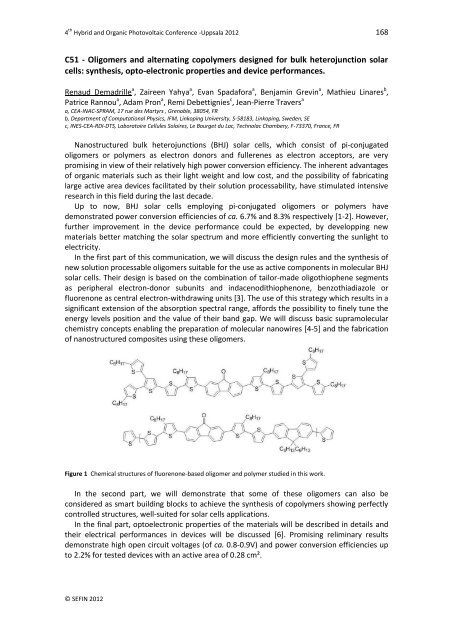HOPV12 - Blogs
HOPV12 - Blogs
HOPV12 - Blogs
Create successful ePaper yourself
Turn your PDF publications into a flip-book with our unique Google optimized e-Paper software.
4 th Hybrid and Organic Photovoltaic Conference -Uppsala 2012 168<br />
C51 - Oligomers and alternating copolymers designed for bulk heterojunction solar<br />
cells: synthesis, opto-electronic properties and device performances.<br />
Renaud Demadrille a , Zaireen Yahya a , Evan Spadafora a , Benjamin Grevin a , Mathieu Linares b ,<br />
Patrice Rannou a , Adam Pron a , Remi Debettignies c , Jean-Pierre Travers a<br />
a, CEA-INAC-SPRAM, 17 rue des Martyrs , Grenoble, 38054, FR<br />
b, Department of Computational Physics, IFM, Linkoping University, S-58183, Linkoping, Sweden, SE<br />
c, INES-CEA-RDI-DTS, Laboratoire Cellules Solaires, Le Bourget du Lac, Technolac Chambery, F-73370, France, FR<br />
Nanostructured bulk heterojunctions (BHJ) solar cells, which consist of pi-conjugated<br />
oligomers or polymers as electron donors and fullerenes as electron acceptors, are very<br />
promising in view of their relatively high power conversion efficiency. The inherent advantages<br />
of organic materials such as their light weight and low cost, and the possibility of fabricating<br />
large active area devices facilitated by their solution processability, have stimulated intensive<br />
research in this field during the last decade.<br />
Up to now, BHJ solar cells employing pi-conjugated oligomers or polymers have<br />
demonstrated power conversion efficiencies of ca. 6.7% and 8.3% respectively [1-2]. However,<br />
further improvement in the device performance could be expected, by developping new<br />
materials better matching the solar spectrum and more efficiently converting the sunlight to<br />
electricity.<br />
In the first part of this communication, we will discuss the design rules and the synthesis of<br />
new solution processable oligomers suitable for the use as active components in molecular BHJ<br />
solar cells. Their design is based on the combination of tailor-made oligothiophene segments<br />
as peripheral electron-donor subunits and indacenodithiophenone, benzothiadiazole or<br />
fluorenone as central electron-withdrawing units [3]. The use of this strategy which results in a<br />
significant extension of the absorption spectral range, affords the possibility to finely tune the<br />
energy levels position and the value of their band gap. We will discuss basic supramolecular<br />
chemistry concepts enabling the preparation of molecular nanowires [4-5] and the fabrication<br />
of nanostructured composites using these oligomers.<br />
Figure 1 Chemical structures of fluorenone-based oligomer and polymer studied in this work.<br />
In the second part, we will demonstrate that some of these oligomers can also be<br />
considered as smart building blocks to achieve the synthesis of copolymers showing perfectly<br />
controlled structures, well-suited for solar cells applications.<br />
In the final part, optoelectronic properties of the materials will be described in details and<br />
their electrical performances in devices will be discussed [6]. Promising reliminary results<br />
demonstrate high open circuit voltages (of ca. 0.8-0.9V) and power conversion efficiencies up<br />
to 2.2% for tested devices with an active area of 0.28 cm².<br />
© SEFIN 2012


